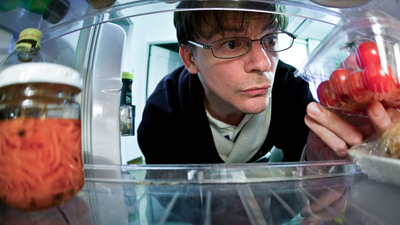
If Everybody Hates Wasting Food, Why Do We (and How Can We Stop)? by Mary Hoff Ensia- This article first appeared on Ensia, a magazine showcasing environmental solutions in action that is powered by the Institute on the Environment at the University of Minnesota.
It was bound to happen. When I first got the assignment to write a story on reducing consumer food waste, I was feeling just a little smug. I’m the one who wraps up breadsticks at the restaurant to take home, slurps the last bit of soup from the bowl, cuts the soft spots out of an apple rather than tossing the whole thing away. But even though I personally don’t waste food, plenty of people do — and this would be my big chance to help reduce the hefty social and environmental costs by exploring why and what we can do about it.
Then I opened my refrigerator. Pulling out what I thought was a perfectly healthy stalk of celery, I found instead the early stages of compost. On the top shelf, a cottage cheese carton disguised leftovers I had diligently squirreled away — and promptly forgotten. And then there was the ketchup. “Best if used by March 2012”? Busted.
Like it or not, when it comes to food waste, it’s not just industrial farms or supermarkets or restaurants or caterers or other people who are to blame: It’s all of us. In fact, according to The Wall Street Journal, more than twice as much food is wasted at the consumer level than at the retail level in the US.
“There’s good news and bad news,” says Jonathan Bloom, author of American Wasteland: How America Throws Away Nearly Half of Its Food (and What We Can Do About It) and perhaps one of the world’s top accumulators of wasted-food facts. “The bad news is that we are pretty wasteful as individuals and families. The good news is we can be a major part of the change with food waste.”
Capitaliing on that concept, government agencies, environmental organizations and other nonprofits around the world have been developing and deploying a spectrum of strategies to help consumers reduce the amount of food we waste, from simple awareness-building social media campaigns to gala events in which celebrity chefs demo innovative approaches to turning leftovers, stale bread, forlorn fruits and the like into culinary creations. In the process, they have learned much about what works — and doesn’t — when it comes to reducing consumer food waste.
Consumer power
Worldwide, one out of every three bites of food produced never makes it to our mouths. Some — especially in developing countries — is lost in harvesting, storage, transportation and so on. But in developed countries, a good chunk gets tossed out after it’s in the consumer’s hands.
“Consumers, especially in Europe and the United States, we are the main food wasters,” says Selina Juul, founder of the Danish food waste reduction campaign Stop Spild Af Mad (Stop Wasting Food), which got its start seven years ago when Juul, who emigrated to Denmark after living in Moscow during the tight times following the collapse of the USSR, decided she had had enough of the profligate attitude toward food in her new setting.
The Food and Agriculture Organization of the United Nations estimates that in North America and Europe the average individual throws out 95 to 115 kilograms (210 to 250 pounds) of food each year. In the US, that number is more like 290 pounds (130 kilograms), according to US Department of Agriculture’s Economic Research Service estimates.
Half a super-size jar of jam that was such a good deal but you likely couldn’t consume in a lifetime … the apple and bag of chips prepackaged in the deli lunch … a papaya you purchased but weren’t quite sure how to prepare. It all adds up.
But why is wasting food such a big deal anyway?
For the individual, wasting food is, simply put, wasting money. “One of the things I find so odd is we’re so attuned to the savings on the front end,” Bloom says. “We’ll change what we’re going to buy based on sale items at the supermarket, but we don’t ever think about the cost of food waste on the other side of the equation and how much that adds up to.” On average, according to the US Department of Agriculture, an American family of four throws out close to US$1,500 worth of food in a year. Read more (Courtesy Our World-United Nations University)
